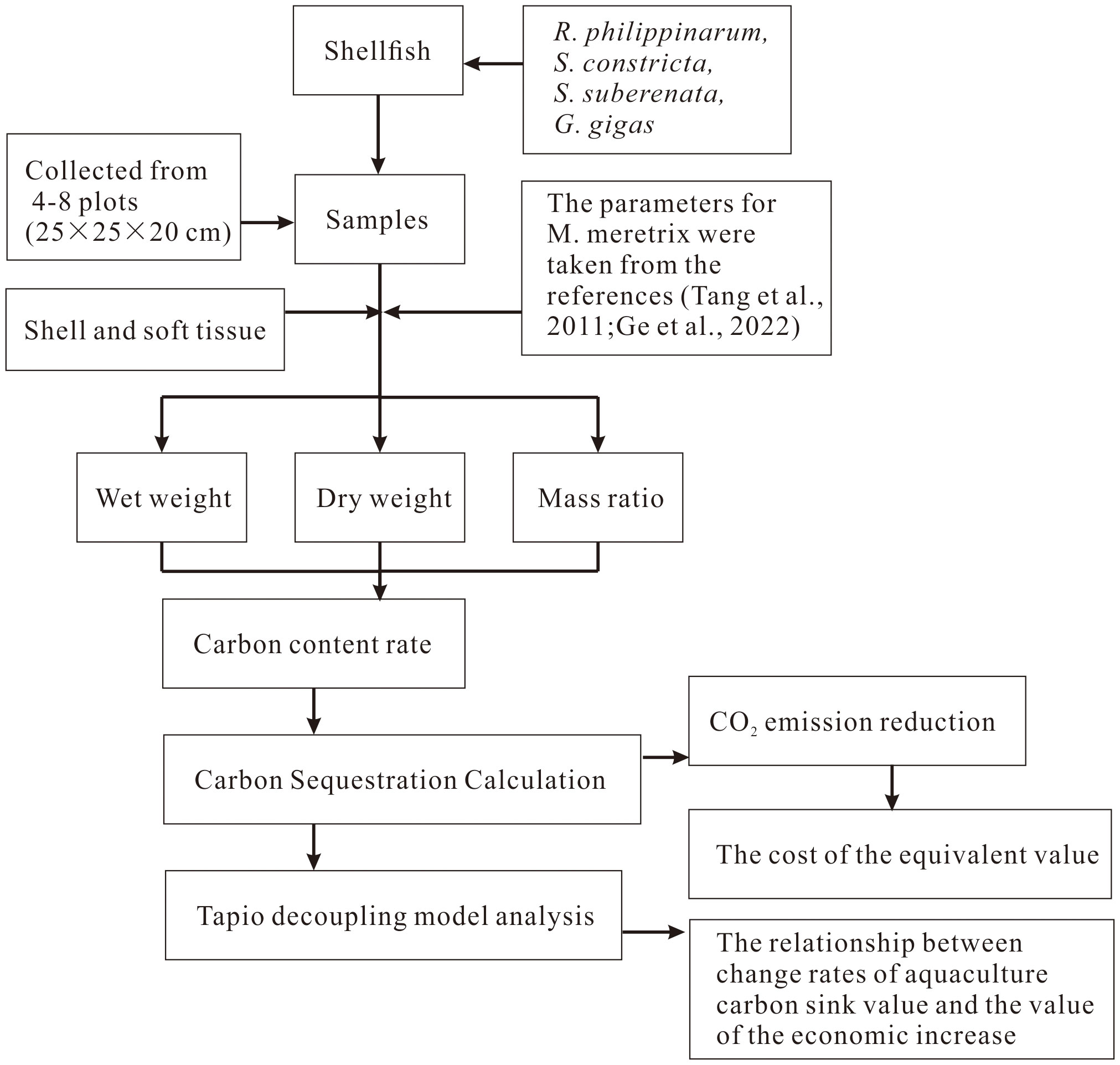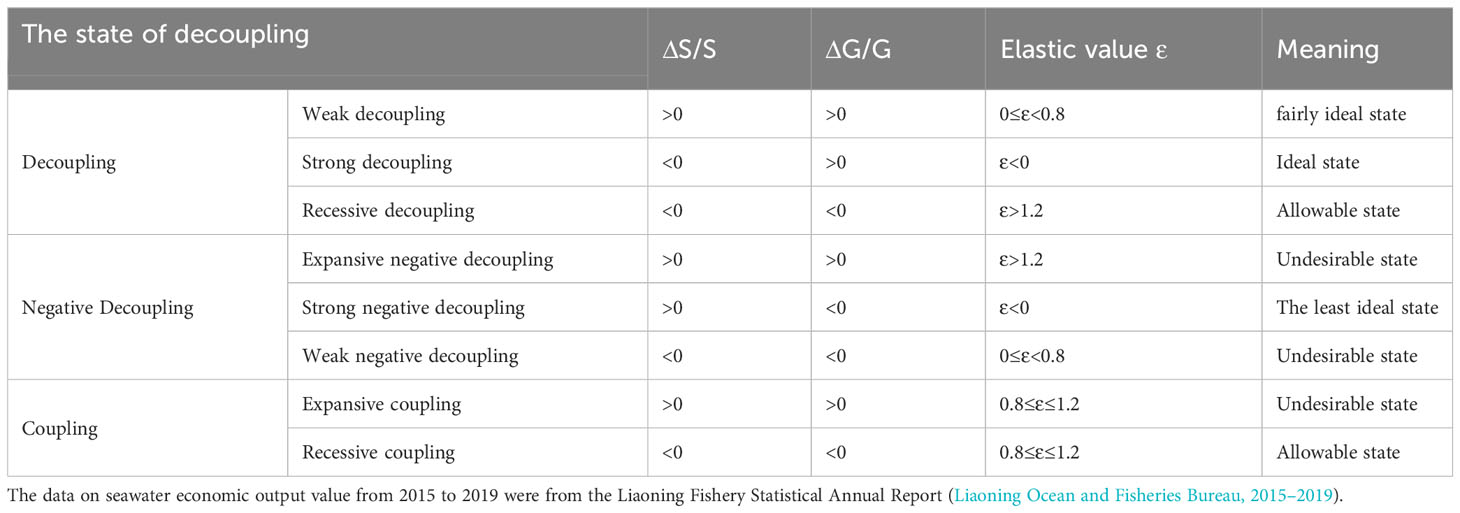Assessment of carbon sink capacity and its value accounting for a farmed shellfish in the coastal wetland of the Yalu River Estuary
- 1Yantai Research Institute, China Agricultural University, Yantai, China
- 2College of Chemistry and Chemical Engineering, Ocean University of China, Qingdao, China
- 3National Marine Environmental Monitoring Center, Ministry of Ecology and Environment of the People’s Republic of China, Dalian, China
- 4State Environmental Protection Key Laboratory of Marine Ecosystem Restoration, Ministry of Ecology and Environment of the People's Republic of China, Dalian, China
- 5Frontiers Science Center for Deep Ocean Multispheres and Earth System, and Key Laboratory of Marine Chemistry Theory and Technology, Ministry of Education, Ocean University of China, Qingdao, China
The carbon sink of cultivation shellfish in coastal wetlands is characterized as both highly ecological and economic value, thus making great contributions to achieving carbon neutrality. In this study, the main species of cultured shellfish (Ruditapes philippinarum, Meretrix meretrix, Sinonovacula constricta, Scapharca suberenata, and Grassostrea gigas) were selected as the research objects in the coastal wetland of the Yalu River Estuary to measure shellfish yields and carbon contents. Combined with the data from the cultured shellfish of fishery statistics of Donggang city, Dandong, Liaoning Province, China, the carbon sequestration capacity was calculated, and the carbon sink values of cultured shellfish also evaluated on the base of the diverse shellfish carbon sequestration ratios. The carbon sink conversion ratio of cultivation shellfish decreased in the following order: S. suberenata, R. philippinarum, G. gigas, S. constricta, and M. meretrix. The total carbon sequestration of cultured shellfish in the Yalu River Estuary Coastal Wetland from 2015 to 2019 was approximately 110,500 tC. The yield and the carbon sequestration quantity of R. philippinarum accounted for 76.60~83.30% of the total yield and 79.07~85.41% of the total carbon sequestration quantity. The value of the carbon sink was approximately 63,710,600 yuan. Among the species of cultured shellfish, R. philippinarum was the largest contributor to the carbon sink value. Based on Tapio’s decoupling model, R. philippinarum has the most ideal state of decoupling between carbon sink and economic growth of cultured shellfish, followed by M. meretrix and S. suberenata. Our results illustrate that the development of coastal wetland shellfish aquaculture has a positive contribution to reducing carbon emissions and increasing carbon sinks.
1 Introduction
Global climate change is regarded as one of the most serious challenges facing the sustainable development of mankind (Yu et al., 2021). Since the beginning of the industrial era, long-lived greenhouse gases, such as carbon dioxide (CO2), methane, nitrous oxide, etc, have caused an obvious increase in global warming (Wang et al., 2017). Atmospheric CO2 concentrations have risen by around 40% during the last 150 years. The massive emission of CO2 from human activities is the most significant driver of observed climate change since the mid-20th century (IPCC et al., 2013). Reducing and controlling carbon dioxide emissions has become one of the biggest issues for countries to curb the growth of carbon emissions.
The mariculture industry has a large carbon sink potential, and thus it is considered as a green and low-carbon production mode to support the goal of carbon neutrality (Liu and Tang, 2011; Li et al., 2023). Shellfish is a key component in marine ranching, which represents an important marine biological C sink due to high biodeposition and calcification rates (Feng et al., 2022; Wang et al., 2022). Shellfish mainly react with HCO3- in seawater to form CaCO3, thus forming carbon sinks. The soft tissue, however, filters and lives on microalgae and organic particles in seawater to promote growth. Ultimately, harvesting shellfish enables carbon sequestration by directly removing large amounts of carbon from seawater (Zhang et al., 2005). The amount of CO2 released by shellfish through respiration and calcification during their growth is far less than the amount of CO2 stored in seawater as metabolites and is removed from seawater as ecological products (Fodrie et al., 2017; Feng et al., 2022; Jiang et al., 2022). Although CO2 release is a by-product of carbonate shell production, shellfish is overwhelmingly regarded to have a carbon sink function in the ecosystem that can remove carbon from seawater and store it for a long time (Qi et al., 2012; Yue and Wang, 2012; Li, 2014; Yu et al., 2020). Culturing shellfish in the tidal flat wetland is one of the most efficient methods of biological carbon sequestration (Tang et al., 2011, Tang et al., 2022). Several studies have been conducted to estimate the growth and carbon content of shellfish cultivation (Quan et al., 2014; Fodrie et al., 2017). The previous research had demonstrated that moderately increasing shellfish can improve the carbon sequestration capacity as well as carbon sink service functions (Li et al., 2023). Carbon sequestration in shellfish cultivation depends on site characteristics and plantation management, especially in intertidal wetland and estuarine wetland ecosystems. It is still difficult to accurately quantify the amount of shellfish cultivation carbon sequestration, due to the lack of site-specific data and specie-specific data (Feng et al., 2022).
The ecological and economic values of shellfish include product value, carbon storage value, oxygen release value and purification value (Fodrie et al., 2017; Liu et al., 2019; Hao et al., 2020). Among them, carbon sink provides material products and environmental conditioning services, and provides the provision service value and regulating service value (Tang et al., 2018). The calculation of economic values of shellfish carbon sinks can provide a data reference for shellfish cultivation industry subsidies and improve the production enthusiasm of the carbon sink culture industry (Jiang et al., 2022; Wen et al., 2022). Recently, the ecological values of blue carbon have been evaluated by the market valuation method, alternative cost method, and contingent value method (Qin et al., 2015; Zheng et al., 2019; Trégarot et al., 2020; Hu et al., 2024). Despite vast literature on shellfish product value and related functions (Kirwan and Mudd, 2012; Duarte et al., 2016; Kara et al., 2018), few studies have examined the values of cultured shellfish carbon sink.
Carbon emissions is closely related to economic growth and structural adjustment in a region or country. How to achieve dynamic and coordinated development of regional economic growth and CO2 emissions, which is vital for China to achieve green and sustainable development. It is necessary to clarify the relation of the carbon emission with the economic growth. Decoupling theory was first used to analyze the dynamic process between the two closely related variables from the beginning to the end of decoupling (Tapio, 2005). Recently, decoupling theory has been applied to analyze the idealized relationship between CO2 and economic growth during decoupling (Zhong et al., 2012; Cao et al., 2015; Shao et al., 2019a). Shellfish farming in coastal waters is a very important industry in China. If the rate of the aquaculture’s carbon sink is negative or lower than the rate of economic growth, this process should be regarded as a form of decoupling (Shao et al., 2019a; Cao and Wang, 2020; Zhao et al., 2022). Previous research has proved that culture efficiency effect has a strong driving effect on the total economic value of carbon sinks in cultivated seaweeds and the total economic value of cultivated seaweeds can be improved by adjusting the cultivation species (Yu et al., 2023). However, the decoupling model to evaluate the relationship of CO2 emission with economic growth is relatively simple, especially for the selection of indicators and determination of native parameters. Efforts should be made to enhance the function and value of cultivated shellfish carbon sink, thus it is necessary to promote the high-quality development of the fishery industry.
In this study, five species of cultured shellfish (Ruditapes philippinarum, Meretrix meretrix, Sinonovacula constricta, Scapharca suberenata, and Grassostrea gigas) were selected to measure carbon sequestration parameters and the Yalu River Estuary was chosen as a representative of coastal wetland of China. The fishery statistics data was collected in the last five years and a decoupling elasticity theory (Tang et al., 2011; Qi et al., 2012; Li, 2014; Shao et al., 2018) was applied. The objectives of this study are: (1) to calculate the carbon sink capacity of cultured shellfish; (2) to study the relationship between the change rates of aquaculture carbon sink value and the value of the economic increase.
2 Research methods
2.1 Research region
The Yalu River Estuary Coastal Wetland National Nature Reserve (Figure 1) is in Donggang city (E123°34′20″~E124°07′28″, N39°40′06″~N39°58′24″), Liaoning Province, covering an area of 10,100 hectares. It contains land, beach and ocean ecosystems and forms complex and multiple ecosystem types, including reed wetlands, marshes, lake basin bogs, tidal marshes, and estuaries. There are 7 large rivers in the reserve. Among them, the substrates of the Yalu River and the Dayang River in the intertidal zone are suitable for annelid and mollusk growth. The quantity of nutrients and organic matter carried by these two rivers offers sufficient food to benthic organisms. The reserve is one of the significant shellfish production areas in Liaoning Province (Li et al., 2014). The main shellfish culture method used in this area is beach cultivation, and there is a small amount of mixed aquaculture of shellfish, shrimp, and jellyfish above the coastline.
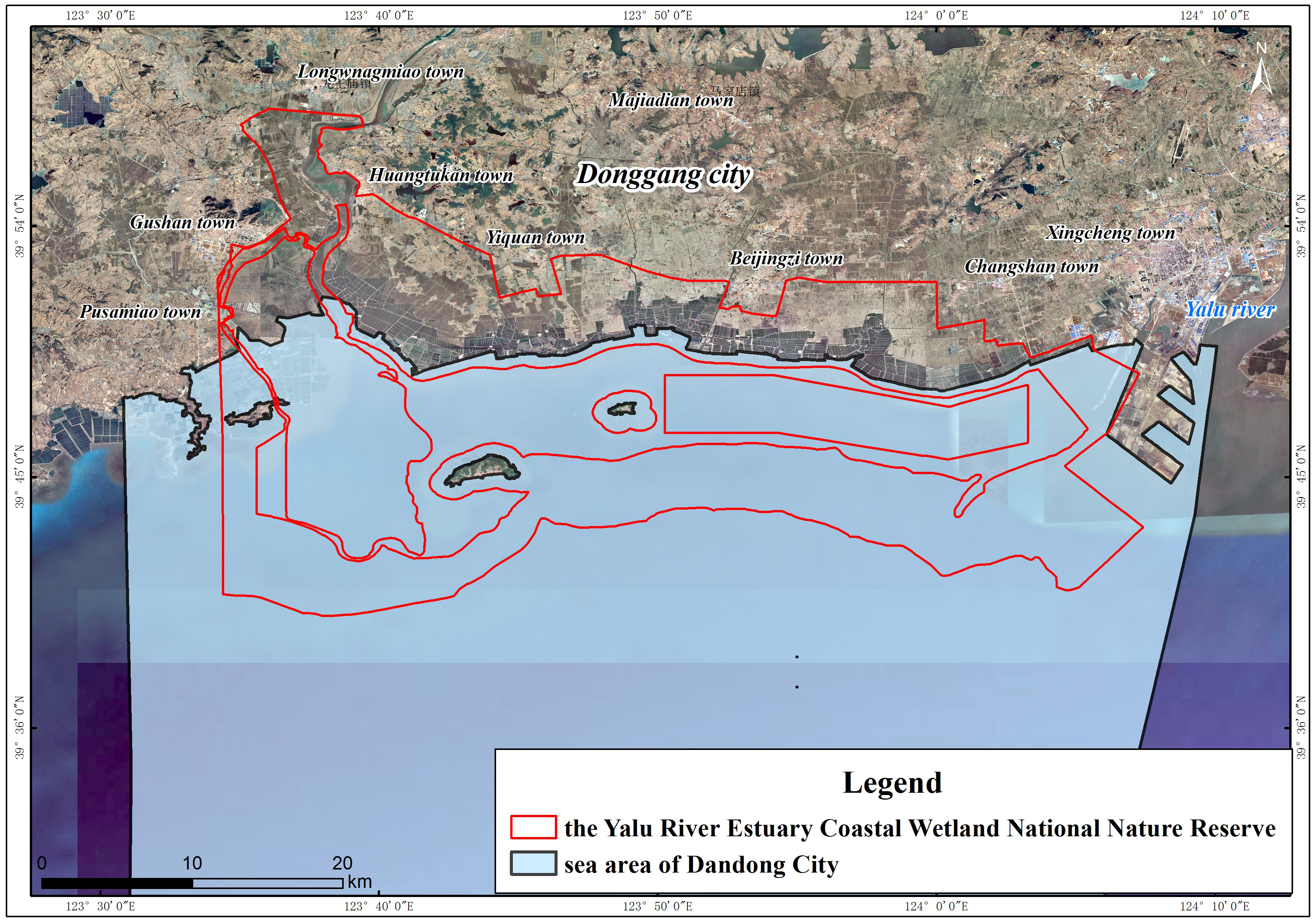
Figure 1 The map shows the location of the Yalu River Estuary Coastal Wetland National Nature Reserve. The red line draws a range of the reserve, and the blue area shows the sea area of Donggang city, Dandong, a county-level city in Liaoning Province, located in southeastern Liaoning Province and southwestern Dandong city.
2.2 Data sources and processing
The Yalu River Estuary Coastal Wetland National Nature Reserve has the characteristics of zonal distribution along the coastline in Donggang city, Liaoning Province, from east to west. This wetland intertidal zone is a breeding base of the harbor and serves as a beach in Donggang city. As a result, we obtained data from Donggang city’s shellfish culture statistics to represent the breeding conditions of the Yalu River Estuary Coastal Wetland.
The data on the varieties, culture area and yield of cultured shellfish from 2015 to 2019 were from the Liaoning Province Fishery Statistics Annual Report (Liaoning Ocean and Fisheries Bureau, 2015-2019). The Rst (dry weight ratio of soft tissue) and Rs (dry weight ratio of shell) of Grassostrea gigas, Scapharca suberenata, Sinonovacula constricta and Ruditapes philippinarum were measured in the coastal wetland of the Yalu River Estuary in 2018. The sample collection method was based on national guidelines (Standardization Administration of the People’s Republic of China, 2007). Shellfish were collected from 4-8 plots (25×25×20 cm) at each station, and the shellfish were screened by using a sieve with a pore size of 0.37 mm and a diameter of approximately 40 cm. The selected shellfish were put into sealed bags and placed in cold storage. The relevant parameters were determined according to the Chinese industrial standard (Ministry of Natural Resources, People’s Republic of China, 2021). Thirty samples were randomly selected, and the shell length, shell height and shell width of each species were measured by a Vernier caliper. The shellfish samples were weighed by an electronic balance (wet weight). Furthermore, the wet weight of the shell and soft tissue was weighed. Shell and soft tissue were washed with distilled water. Then, their surfaces were dried, and their wet weights were determined. The dry weight, dry-wet ratio and mass ratio were recorded after drying at 60°C for 48 h. The dried samples were then ground into powder and sieved to 80 mesh (178 μm), and the rate of carbon content was determined by an elemental analyzer. Additionally, the instrument parameters were set according to the manufacturer’s instructions, and the samples were embedded based on the sample requirements. Moreover, three parallel samples were fixed for each sample, and average values were calculated. Note that the parameters for Meretrix meretrix were taken from the references (Tang et al., 2011; Ge et al., 2022). A flow chart of the method in this paper is presented in Figure 2.
2.2.1 Calculation of cultured shellfish carbon sequestration
The carbon sequestration amount of cultured shellfish is calculated by their yield and carbon content (Tang et al., 2011; Qi et al., 2012; Li, 2014; Shao et al., 2018). The formula is as follows:
where Sa is the shellfish carbon sequestration, Pi is the ith kind of shellfish yield, Rst is the dry weight of soft tissue, WCst is the percentage of carbon content of soft tissue, Rs is the dry weight of the shell, and WCs is the percentage of carbon content of the shell. The different cultured shellfish parameters are shown in Table 1.
2.2.2 Calculation of cultured shellfish carbon sink value
The formula for the carbon sink value of cultured shellfish (Tang et al., 2011; Qi et al., 2012; Li, 2014; Shao et al., 2018) is as follows:
where V is the cultured shellfish carbon sink value, Va is the cost of the equivalent value of CO2 emission reduction, Sa is the carbon sequestration of shellfish, and K is the conversion coefficient.
Research has shown that a CO2 emission reduction is equivalent to the cost of the equivalent value of 157 yuan per ton in Liaoning Province (Cao et al., 2019; Yu et al., 2020). Therefore, in this study, we selected 157 yuan/t as the equivalent value cost of cultured shellfish CO2 emission reduction in the Yalu River Estuary Coastal Wetland.
The carbon sequestration value of different types of shellfish was calculated based on the diverse shellfish carbon sequestration ratios in Table 1. The conversion coefficient is the ratio of the CO2 and C molecular weight, and the ratio is 3.67(44/12) (Ge et al., 2022).
2.2.3 Tapio decoupling model
A decoupling elasticity theory (Tang et al., 2011; Qi et al., 2012; Li, 2014; Shao et al., 2018) was selected to study the relationship between the change rates of aquaculture carbon sink value and the value of the economic increase. The following formula was used:
where ε is the decoupling elasticity. and are for the tth period of cultured shellfish carbon sink quantities and the economic output of aquaculture, respectively. is the annual growth rate of cultured shellfish carbon sink quantities. is the annual growth rate of the economic output of aquaculture.
The decoupling states should be divided into 3 parts (negative decoupling, decoupling, coupling) by the decoupling elastic values of 0.8 and 1.2. Then, these states can be subdivided into 8 specific states in light of the numerical value (Table 2) (Cao and Wang, 2020; Liu et al., 2022).
2.2.4 Model uncertainty analysis
The uncertainty should be noticed when using the Tapio decoupling model. For example, the diversity of data sources and statistics, the patio-temporal representation of sampled quadrats, and the accuracy of data measurement, these uncertainties could interfere with the decoupling model. If the uncertainties are used during the data analyses, the accuracy of the analyses will probably become better. However there are difficulties in analyzing the uncertainties in temporal trends. And there are no good estimates for temporal comparisons of every shellfish species. The results may be relatively high. Another pitfall emerges from the incomparable methods used in obtaining the data, which makes it difficult to compare the size of different shellfish. However, as long as the different methods do not affect a bias in the temporal growth rate, this problem is less severe in defining whether decoupling occurs or not.
3 Results and discussion
3.1 Carbon sequestration quantities of cultured shellfish
Research shows that from 1999 to 2008, through the harvest of farmed shellfish, the amount of carbon removed from China’s offshore every year is 700,000 to 990,000 t (an average of 860,000 t), of which 670,000 t of carbon was removed from the ocean in the form of shells (Zhang et al., 2005; Tang, 2011). From 2015 to 2017, the average annual carbon removal of maricultured algae and shellfish in Liaoning Province was about 27,700 tons, equivalent to the reduction of 1108,200 million tons of CO2 (Cao et al., 2019).
From 2015 to 2019, the total carbon sequestration quantity of cultured shellfish was approximately 110,500 tC along the coastal wetland of the Yalu River Estuary, and the annual average carbon removal was approximately 22,100 t. Based on the annual average carbon removal of maricultured shellfish of 166,800 t for Liaoning Province (Yin et al., 2022), the annual carbon sequestration of cultured shellfish in the coastal wetland of the Yalu River Estuary comprised 13.25% of the total provincial level. The higher the yield of cultured shellfish was, the greater the carbon sequestration (Yue and Wang, 2012; Zhang et al., 2013). From 2015 to 2019, the shellfish species cultured in the coastal wetland of the Yalu River Estuary were mainly R. philippinarum. Their culture area accounted for 66.67~81.87% of the total area, their yield accounted for 76.60~83.30% of the total yield, and the carbon sequestration accounted for 79.07~85.41% of the total. The second main species of cultured shellfish were S. constricta and S. suberenata. The culture area of S. constricta accounted for 1.53~2.72%, the yield accounted for 10.74~12.39%, and the carbon sequestration accounted for 8.91~10.08%. In addition, the culture area of S. suberenata accounted for 12.6~23.81%, the yield accounted for 1.67~7.77%, and the carbon sequestration accounted for 1.68~8.53% (Figure 3). To the extent of the yield of the unit culture area and quantity of carbon sequestration, in the past few years, the unit area yield of S. constricta was the highest and increased continuously each year, except for G. gigas in 2019, which reached a quantity of 39.63 t/hm2 in 2019 (Figure 3). Nevertheless, the unit area yield and the amount of carbon sequestration of R. philippinarum were lower than those of S. constricta, although its culture area and yield were the highest (Figures 3, 4). This result is consistent with the results of previous studies showing a linear relationship between the production of marine shellfish aquaculture and the carbon sequestration (Yue and Wang, 2012).
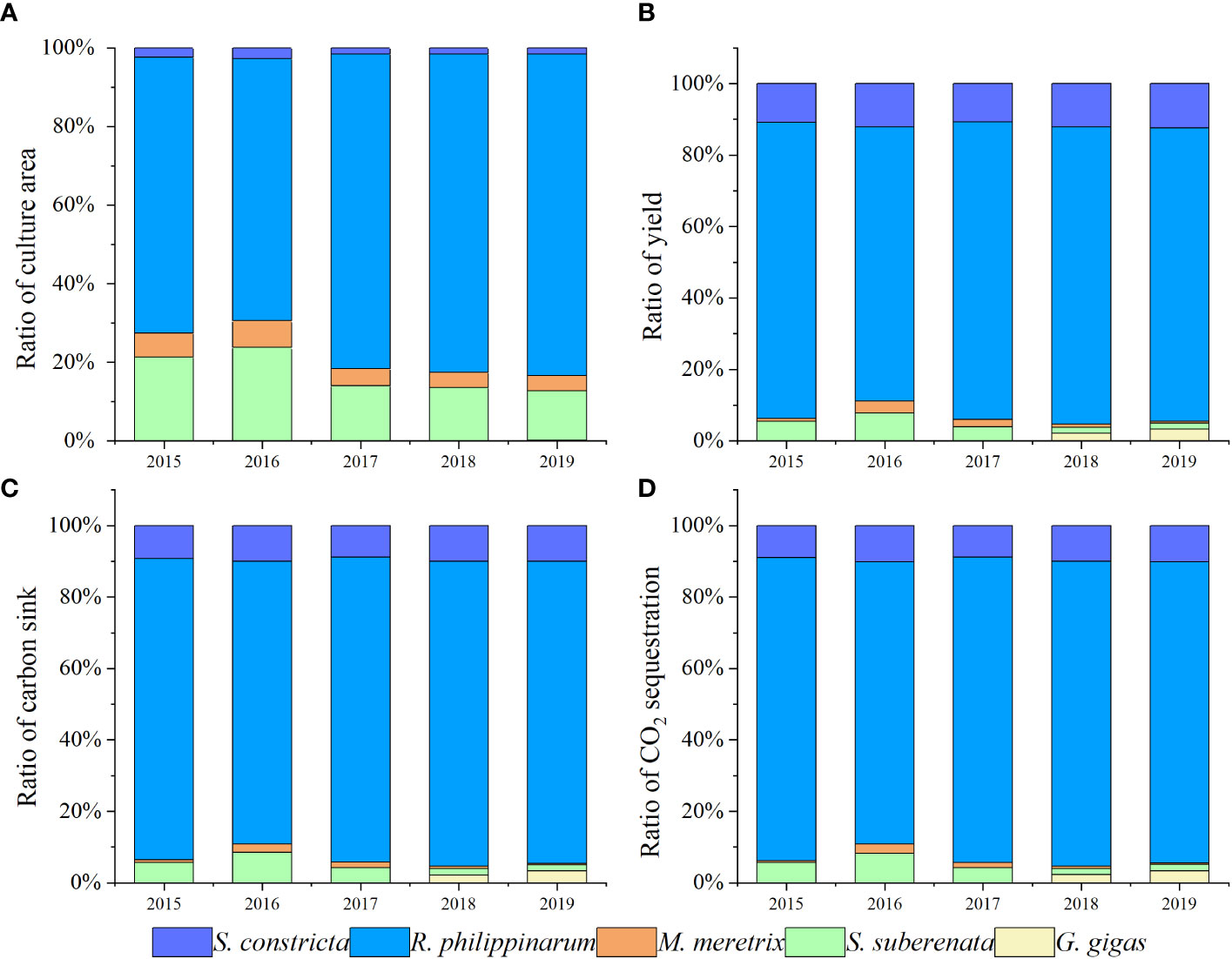
Figure 3 The proportion of each accounting value (A: the ratio of culture area; B: the ratio of yield; C: the ratio of carbon sink; D: the ratio of CO2 sequestration) of different kinds of cultured shellfish from 2015 to 2019 in the coastal wetland of the Yalu River Estuary. The data on varieties, culture area and yield of cultured shellfish from 2015 to 2019 were from the Liaoning Province Fishery Statistics Annual Report (Liaoning Ocean and Fisheries Bureau, 2015–2019).
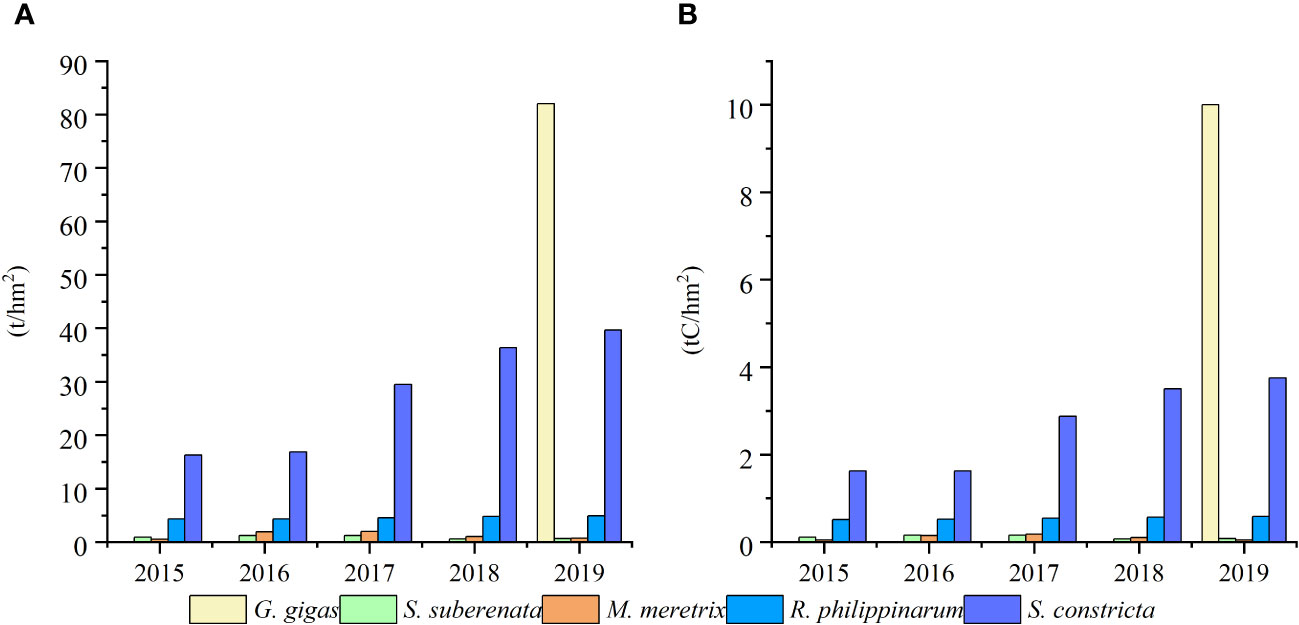
Figure 4 (A) The yield and (B) the quantity of carbon sinks of different shellfish per unit culture area (hectare) from 2015 to 2019 in the coastal wetland of the Yalu River Estuary. The data on varieties, culture area and yield of cultured shellfish from 2015 to 2019 were from the Liaoning Province Fishery Statistics Annual Report (Liaoning Ocean and Fisheries Bureau, 2015–2019).
In conclusion, among the cultured shellfish of the Yalu River Estuary Coastal Wetland, R. philippinarum had the highest proportion of yield and carbon sequestration of the total amounts, and S. constricta had the second highest proportions (Figure 3).
Due to the lack of samples of externally attached organisms and sediments during sampling, the carbon sequestration calculations for these two types of samples were not included in this study. Although this result does not fully reflect the entire process of carbon sequestration of cultured shellfish (Wen et al., 2022), as the most important ecologically relevant product of coastal wetland culture in the Yalu River Estuary, the carbon sink capacity of cultured shellfish directly reflects the carbon sink importance of ecological products in the region.
The carbon sink conversion ratio of cultured shellfish is the ratio of carbon sequestration to yield and is one of the most important values for measuring the carbon sink capacity of aquaculture (Yue and Wang, 2012; Shao et al., 2018). From 2015 to 2019, the average carbon sink conversion ratio of different cultured shellfish in the coastal wetland of the Yalu River Estuary was, in descending order, S. suberenata, R. philippinarum, G. gigas, S. constricta and M. meretrix (Figure 5). The results showed that S. suberenata had the strongest carbon sequestration capacity. In contrast, the carbon sequestration capacity of shellfish in Liaoning Province was ranked in descending order as S. constricta, R. philippinarum, M. meretrix, G. gigas and S. suberenata (Yin et al., 2022), indicating that the same cultured species exhibited different carbon sequestration capacities in different breeding environments. However, the total carbon sequestration of S. suberenata in the Yalu River Estuary Coastal Wetlands is not incredibly high, mainly due to the limitation of a lack of yield per unit culture area. The average carbon sink conversion ratio of cultured shellfish farmed in coastal wetlands was 10.92 (Figure 5), which was not only higher than the average for Liaoning Province (Shao et al., 2019b) but also higher than the average for other marine areas (Shao et al., 2018; Hong et al., 2022), indicating that the Yalu River Estuary Coastal Wetlands have a locational advantage in deploying carbon sink fishery activities.
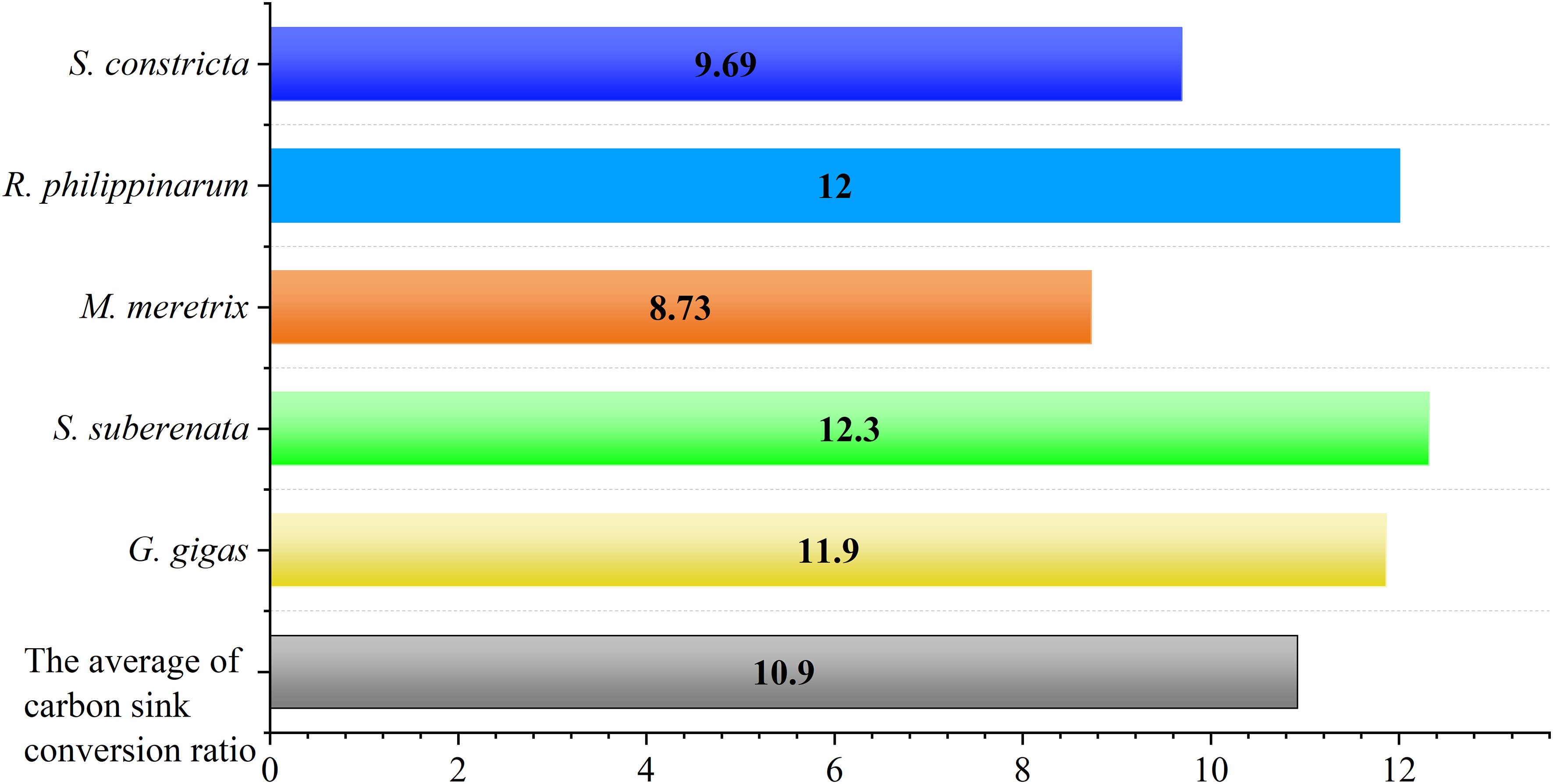
Figure 5 The carbon sink conversion ratios of different cultured shellfish and the average ratio from 2015 to 2019 in the coastal wetland of the Yalu River Estuary. The data on varieties of cultured shellfish from 2015 to 2019 were from the Liaoning Province Fishery Statistics Annual Report (Liaoning Ocean and Fisheries Bureau, 2015–2019).
Therefore, we determined that improving the yield of cultured shellfish or increasing the variety of shellfish with high-level carbon sequestration would be an important way to enhance the carbon sink capacity of cultured shellfish in coastal wetlands.
3.2 Carbon sink value of cultured shellfish
Between 2015 and 2019, the carbon sink value of cultured shellfish in the coastal wetlands of the Yalu River Estuary was approximately 63.71 million yuan, with an annual average of 12.748 million yuan. The average annual carbon sink value of farmed shellfish in Liaoning Province calculated using the same parameters was 1600 million yuan (Yu et al., 2020). Comparatively, the carbon sink value of cultured shellfish in the Yalu River Estuary Coastal Wetlands was approximately 7.97% of the average level in the province. Moreover, shellfish aquaculture in the coastal wetlands of the Yalu River Estuary was mainly beach cultivation, which had little impact on the ecological landscape and caused little damage to the coastal wetland ecosystem.
Suppose fisheries carbon sink projects are included in the China Certified Emission Reduction (CCER) mechanism in the future. In that case, shellfish aquaculture in the Yalu River Estuary Coastal Wetlands can be an effective way to help achieve carbon peaking and carbon neutrality goals.
At the same time, The Yalu River Estuary Coastal Wetland National Nature Reserve, as a trading entity for carbon sink property rights in marine fisheries, can receive over 10 million yuan annually for wetland restoration and maintenance, ecological replenishment, wetland ecological monitoring, etc. in protected areas, which is basically equivalent to the central government wetland subsidy funds received by Dandong in 2021 (Liaoning Forestry and Grassland Bureau, 2022), providing strong financial support for achieving coordinated development of fishery economy and ecology.
In terms of aquaculture species, R. philippinarum was the largest contributor to the annual average carbon sink value, accounting for approximately 84.36%, followed by S. constricta, at 9.65%. On average, S. constricta had an annual carbon sink value per unit aquaculture area of 1,537 yuan/hm², which was second only to that of G. gigas. The culture of M. meretrix had the lowest contribution to the average annual carbon sink value, at only 0.94%. G. gigas has been cultured since 2018, and the breeding scale is generally very small. Despite its high average annual carbon sink value per unit area, it has contributed little to the cultured shellfish’s total carbon sink value (Figure 6). At present, the quantity of shellfish larvae from R. philippinarum in the coastal wetlands of the Yalu River Estuary accounts for more than 80% of the total amount of larvae (Yu, 2022), and there is still potential to adjust its culture structure from a carbon sink point of view. Consequently, an in-depth quantitative study of the carbon sequestration mechanism of cultured shellfish in coastal wetlands and a further accurate accounting of the carbon sink value of cultured shellfish may provide a foundation for enhancing the carbon sink value of fisheries, formulating a coastal wetland resource protection plan, and maximizing ecosystem service functions.
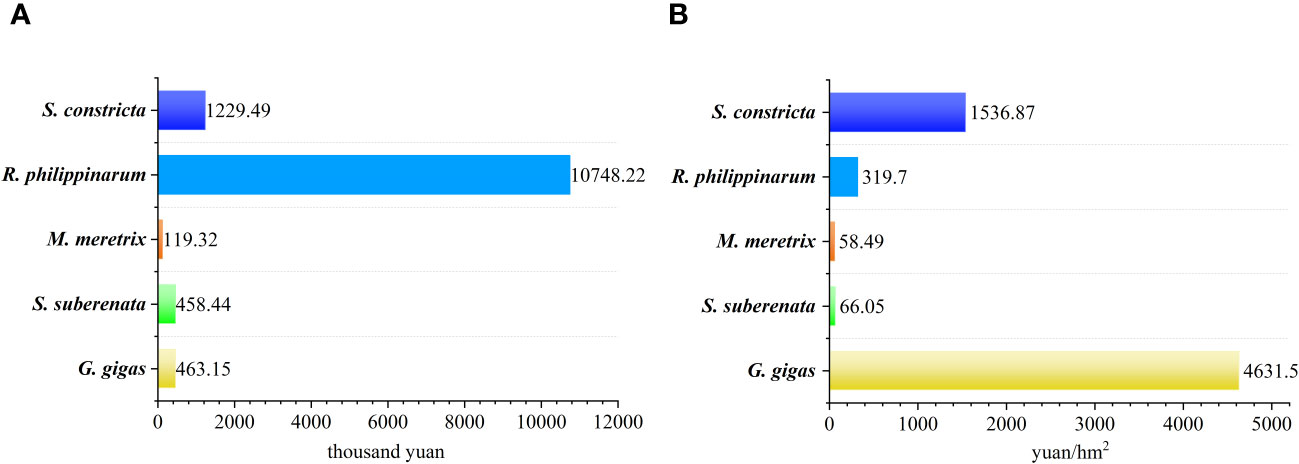
Figure 6 (A) The average annual carbon sink value and (B) the average annual carbon sink value per culture area of different cultured shellfish from 2015 to 2019 in the Yalu River Estuary. The data on varieties of cultured shellfish from 2015 to 2019 were from the Liaoning Province Fishery Statistics Annual Report (Liaoning Ocean and Fisheries Bureau, 2015–2019).
3.3 Relationship between carbon sinks of cultured shellfish and local seawater economy
Based on Tapio’s decoupling model, the decoupling relationship between the carbon sink of cultured shellfish in the Yalu River Estuary Coastal Wetland and the seawater economy of the region is shown in Table 3, and there are six different types of elasticity characteristics that define the relationship: strong decoupling, weak decoupling, recessive decoupling, expansive negative decoupling, strong negative decoupling, and expansive coupling. Among them, R. philippinarum had the most ideal state of decoupling between the carbon sink and the economic growth of cultured shellfish. As the main aquaculture species in the coastal wetlands of the Yalu River Estuary, although R. Philippinarum is not optimal in terms of yield per unit area and carbon sequestration, it is yet the optimal species for the coordinated development of carbon sink fisheries economy and ecology in response to the national blue carbon strategy.
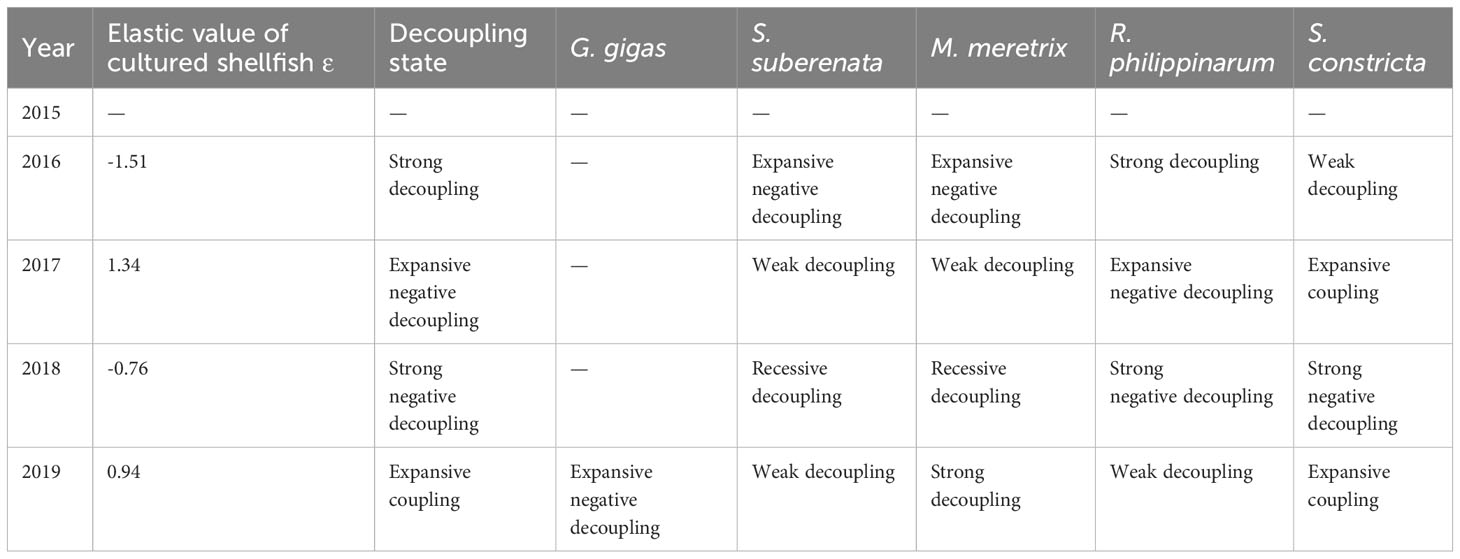
Table 3 The relationship of decoupling between cultured shellfish carbon sinks and the marine economy in the Yalu River Estuary Coastal Wetland from 2015 to 2019.
The carbon sinks of M. meretrix and S. suberenata had a more ideal decoupling state except in 2016. In contrast, the carbon sink of S. constricta with the economic growth rate was in the least ideal state or undesirable state, except in 2016. The carbon sink of G. gigas also showed an undesirable state.
In general, the elastic characteristic frequency of different cultured shellfish was similar, although it may be caused by the accuracy of data measurement or diversity of data sources, that still indicating that the decoupling relationship between the cultured output value and the shellfish carbon sink was not close and that the overall decoupling state was relatively unstable. Especially with the increased cultivation area and yield of S. constricta and G. gigas, their decoupling elasticities represent expansive coupling and strong negative decoupling, respectively, indicating that although they have a strong carbon sink capacity, the environmental costs of culturing these species are higher than the economic benefits.
Therefore, for S. constricta and G. gigas, it is necessary to optimize the aquaculture production process, and reduce unnecessary energy consumption and carbon emissions for promoting the decoupling of these types of shellfish aquaculture from carbon emissions. It is necessary to take the advantages of high carbon sequestration capacity shellfish varieties to continuously improve carbon sink capacity for the farmed shellfish in the Coastal Land of the Yalu River Estuary.
4 Conclusion
In this study, we calculated the cultured shellfish carbon sink capacity and the value of these ecological products in the Yalu River Estuary Coastal Wetland. The carbon sink conversion ratio of shellfish cultured in the coastal wetlands of the Yalu River Estuary decreased in the following order: S. suberenata, R. philippinarum, G. gigas, S. constricta, and M. meretrix. From 2015 to 2019, the average annual carbon sequestration of cultured shellfish in the Yalu River Estuary Coastal Wetland was 22,100 tons, accounting for 13.25% of the average in the province.
The yield and the carbon sequestration quantity of R. philippinarum accounted for 76.60~83.30% of the total yield and 79.07~85.41% of the total carbon sequestration quantity but had less carbon sequestration per unit area than did S. constricta. The total production and carbon sequestration of S. constricta was second only to that of R. philippinarum. Apart from G. gigas, S. constricta had the highest carbon sequestration quantity per unit area and showed a year-on-year upward trend, reaching 3.75 t C/hm2 in 2019. The total 5-year carbon sink value was approximately 63.71 million yuan with an average of 12.74 million yuan per year. R. philippinarum was the largest contributor to the carbon sink value. Improving the production per unit farming area or increasing the proportion of farming of high carbon sink species can effectively improve the total carbon sink capacity of coastal wetlands. R. philippinarum had the most ideal decoupling state of carbon sink and economic growth of cultured shellfish, followed by S. suberenata and M. meretrix. Combined with the carbon sink capacity measurement results, the primary increase in the high carbon sink conversion ratio and high environmental benefits of farmed species are R. philippinarum and S. suberenata, followed by M. meretrix. The development of coastal wetland shellfish aquaculture has a positive contribution to reducing carbon emissions and increasing carbon sinks.
Data availability statement
The original contributions presented in the study are included in the article/supplementary material. Further inquiries can be directed to the corresponding authors.
Ethics statement
The manuscript presents research on animals that do not require ethical approval for their study.
Author contributions
YH: Conceptualization, Data curation, Formal analysis, Writing – original draft. ZT: Formal analysis, Software, Writing – review & editing. YC: Data curation, Investigation, Project administration, Supervision, Writing – review & editing. SL: Funding acquisition, Methodology, Project administration, Resources, Supervision, Validation, Writing – review & editing. GZ: Data curation, Formal analysis, Investigation, Software, Visualization, Writing – review & editing. QW: Data curation, Investigation, Visualization, Writing – review & editing. QL: Data curation, Investigation, Software, Visualization, Writing – review & editing.
Funding
The author(s) declare financial support was received for the research, authorship, and/or publication of this article. This work was funded by the Pilot Study on Entrusted Agent Mechanism for Ownership of Nationally Owned Natural Resource Assets in Liaoning Province (Marine Resources) (2022-K-073), the Pilot Study on Entrusted Agent Mechanism for Ownership of Marine Resource Assets in Dandong Municipality (2022-K-129), Laoshan Laboratory (LSKJ202203901), and the National Natural Science Foundation of China (42201070).
Conflict of interest
The authors declare that the research was conducted in the absence of any commercial or financial relationships that could be construed as a potential conflict of interest.
Publisher’s note
All claims expressed in this article are solely those of the authors and do not necessarily represent those of their affiliated organizations, or those of the publisher, the editors and the reviewers. Any product that may be evaluated in this article, or claim that may be made by its manufacturer, is not guaranteed or endorsed by the publisher.
References
Cao Q. R., Liu S. L., Zheng W. (2019). The carbon dioxide emission reduction targets of provincial regions of China and their cost sharing. J. Stat. Inf. 34, 114–120. doi: 10.3969/j.issn.1007-3116.2019.04.015
Cao G. X., Liu Y. Q., Zhou Y. (2015). Study on carbon emission decoupling of the manufacturing industry in Yangtze river delta area. Yuejiang Acad. J. 7, 37–44.
Cao L., Wang Y. (2020). Estimation of carbon sink potential of marine aquaculture and its decoupling from economic development: taking the three major coastal regions for example. Mar. Econ. 10, 48–56. doi: 10.3969/j.issn.2095-1647.2020.05.006
Duarte M. C., Losada J. I., Hendriks E. I., Mazarrasa I., Mazarrasa M. N. (2016). Correction: Corrigendum: The role of coastal plant communities for climate change mitigation and adaptation. Nat. Clim. Change 6, 802.
Feng J., Zhang T., Ma P. Z., Bai T., Xu J. L., Wang H. Y., et al. (2022). Research progress and the prospect of oyster reef carbon source and sink functions. Prog. Fish. Sci. 43, 1–10. doi: 10.19663/j.issn2095-9869.20220222003
Fodrie F. J., Rodriguez A. B., Gittman R. K., Grabowski J. H., Lindquist N. L., Peterson C. H., et al. (2017). Oyster reefs as carbon sources and sinks. P. R. Soc B-Biol. Sci. 284, 20170891. doi: 10.1098/rspb.2017.0891
Ge H. X., Zhao J., Dong Z. G. (2022). Production status and carbon sink assessment of marine shellfish in Jiangsu province from 2016 to 2020. J. Jiangsu Ocean Univ. (Nat. Sci. Edit.). 31, 1–6. doi: 10.3969/j.issn.2096-8248.2022.02.001
Hao L. H., He S., Chen S., Zhao D. B., Hu D. J. (2020). Evaluation method and application on regulating service value in marine ecosystem: Wenzhou city's practice. Acta Ecol. Sin. 40, 4264–4278. doi: 10.5846/stxb201911012305
Hong X. G., Wang K., Song H. J., Chu J. S., Zhang Z. H. (2022). Carbon sink accounting and capacity assessment of mariculture in Changdao, Shandong Province. Ocean Dev. Manage. 8, 12–16. doi: 10.3969/j.issn.1005-9857.2022.8.hykfygl202208002
Hu S. S., Zou D. H., Zhou K., Wang Z. Y. (2024). Evaluation for ecological services of macroalgae in the seaweed beds of the eastern coastal waters of Shenzhen, China. Chin. J. Ecol. 43, 224–233. doi: 10.13292/j.1000-4890.202401.005
IPCC, Stocker T. F., Qin D., Plattner G. K., Midgley P. M. (2013). The physicalscience basis. contribution of working group I to the IPCC fifth assessment report of the intergovernmental panel on climate change. Clim. Change. 2013.
Jiang Z. J., Fang J. G., Mao Y. Z., Jiang W. W., Fang J. H., Lin F., et al. (2022). Research progress on the carbon sink function of filter-feeding shellfish mariculture and future scientific issues. Prog. Fish. Sci. 43, 106–114. doi: 10.19663/j.issn2095-9869.20220225002
Kara R. R., Ryan P. M., Amanda R. C., Christina E. P., Ioana B., Barbara C. C., et al. (2018). Coastal blue carbon assessment of mangroves, salt marshes, and salt barrens in Tampa Bay, Florida, USA. Estuar. Coast. 41, 1496–1510. doi: 10.1007/s12237-017-0362-7
Kirwan M. L., Mudd S. M. (2012). Response of salt-marsh carbon accumulation to climate change. Nature 489, 550–553. doi: 10.1038/nature11440
Li A. (2014). Assessing Carbon Sink Capacity of Marine Bivalves in Hebei Province (Master of Science. Baoding: Hebei University).
Li Z. P., Chen Y., Wang G., Mu J. D., Sun Y. F., Yu H. L., et al. (2023). Ecological carrying capacity and carbon sequestration potential of bivalve shellfish in marine ranching: A case study in Bohai Bay, China. Front. Mar. Sci. doi: 10.3389/fmars.2023.1174235
Li A., Song L., Jia N., Wang N. B., Song G. J. (2014). Investigation and ecological links analysis of key biological components in wetlands in Yalu river estuary. Wetl. Sci. 12, 374–379. doi: 10.13248/j.cnki.wetlandsci.2014.03.016
Liaoning Forestry and Grassland Bureau (2022). Performance evaluation report for the central financial forestry reform and development funds of Dandong City 2021 (Liaoning: Liaoning Forestry and Grassland Bureau).
Liaoning Ocean and Fisheries Bureau (2015–2019). Liaoning Province Fishery Statistics Annual Report (Liaoning: Liaoning Ocean and Fisheries Bureau).
Liu M. H., Deng X. W., Liu S. N., Sun M. (2022). Carbon emission analysis of Tianjin City based on LMDI method and Tapio decoupling model. Environ. pollut. Contr. 44, 1397–1401. doi: 10.15985/j.cnki.1001-3865.2022.10.022
Liu F. M., Liu D. H., Guo Z. L. (2019). Study on economic value accounting of ocean carbon sink. Mar. Sci. Bull. (Chin. Ed.) 38, 8–19. doi: 10.11840/j.issn.1001-6392.2019.01.002
Liu H., Tang Q. S. (2011). Review on worldwide study of ocean biological carbon sink. J. Fish. Sci. Chin. 18, 695–702. doi: 10.3724/SP.J.1118.2011.00695
Ministry of Natural Resources, People’s Republic of China (2021). Estimation method of maricultural seaweed and bivalve carbon sink-Carbon stock variation method (People’s Republic of China, Beijing: Ministry of Natural Resources).
Qi Z. H., Wang J., Huang H. H., Liu Y., Li C. H., Chen S. J., et al. (2012). Potential assessment of carbon sink capacity by marine bivalves and seaweeds in Guangdong province. South China Fish. Sci. 8, 30–35. doi: 10.3969/j.issn.2095-0780.2012.01.005
Qin C. X., Chen P. M., Zhang A. K., Yuan H. R., Li G. Y., Shu L. M., et al. (2015). Evaluation of ecosystem service and emergy of Wanshan Waters in Zhuhai, Guangdong Province, China. Chin. J. Appl. Ecol. 26, 1847–1853. doi: 10.13287/j.1001-9332.20150331.011
Quan W., Ying M. M., Kang H. J., Zhou Q. H., Xu C. L. (2014). The study of shellfish mariculture and carbon sink capacity in the coastal areas of Zhejiang province. Fish. Modern. 41, 35–38. doi: 10.3969/j.issn.1007-9580.2014.05.008
Shao G. L., Kong H. Z., Li C. (2019a). Net amount of mariculture carbon sink and its coupling relationship with economics growth of China. Resour. Sci. 41, 277–288. doi: 10.18402/resci.2019.02.07
Shao G. L., Liu B., Li C. (2019b). Evaluation of carbon dioxide capacity and the effects of decomposition and spatio-temporal differentiation of seawater in China's main sea area based on panel data from 9 coastal provinces in China. Acta Ecol. Sin. 39, 2614–2625. doi: 10.5846/stxb201801080049
Shao G. L., Zhu R., Li C. (2018). Research on carbon balance of marine fishery in Shandong Province using the calculation results of carbon emission and carbon sink. Chin. Fish. Econ. 36, 4–13. doi: 10.3969/j.issn.1009-590X.2018.04.001
Standardization Administration of the People's Republic of China (2007). Specifications for Oceanographic Survey, Marine Biological Survey (Beijing: General Administration of Quality Supervision, Inspection and Quarantine of the People's Republic of China).
Tang Q. S. (2011). Carbon sink fisheries and rapid development of modern fisheries. Jiangxi Fish. Sci. Technol. 2, 5–7. doi: 10.3969/j.issn.1006-3188.2011.02.002
Tang Q. S., Jiang Z. J., Mao Y. Z. (2022). Clarification on the definitions and its relevant issues of fisheries carbon sink and carbon sink fisheries. Prog. Fish. Sci. 43, 01–07. doi: 10.19663/j.issn2095-9869.20220415001
Tang J. W., Ye S. F., Chen X. C., Yang H. L., Sun X. H., Wang F. M., et al. (2018). Coastal blue carbon: Concept, study method, and the application to ecological restoration. Sci. Sin. (Terrae) 48, 661–670. doi: 10.1007/s11430-017-9181-x
Tang Q. S., Zhang J. H., Fang J. G. (2011). Shellfish and seaweed mariculture increase atmospheric C02 absorption by coastal ecosystems. Mar. Ecol. Prog. Ser. 424, 97–104. doi: 10.3354/meps08979
Tapio P. (2005). Towards a theory of decoupling: degrees of decoupling in the EU and the case of road traffic in Finland between 1970 and 2001. Transp. Policy. 12, 137–151. doi: 10.1016/j.tranpol.2005.01.001
Trégarot E., Touron-Gardic G., Cornet C. C., Failler P. (2020). Valuation of coastal ecosystem services in the large marine ecosystems of Africa. Environ. Dev. 36, 100584. doi: 10.1016/j.envdev.2020.100584
Wang X., Feng J., Lin C., Liu H., Chen M., Zhang Y. (2022). Structural and functional improvements of coastal ecosystem based on artificial oyster reef construction in the Bohai Sea, China. Front. Mar. Sci. 2022. doi: 10.3389/fmars.2022.829557
Wang J., Feng L., Tang X., Bentley Y., Hook M. (2017). The implications of fossil fuel supply constraints on climate change projections: a supply-side analysis. Futures 86, 58–72. doi: 10.1016/j.futures.2016.04.007
Wen R., Zhang J. W., Gao C., Gao Y., Yang Y. (2022). Study on carbon sink price accounting of farmed shellfish. Ocean Dev. Manage. 3, 16–23. doi: 10.20016/j.cnki.hykfygl.20220330.007
Yin Y. W., Che J., Wei H. F., Luo C. H. (2022). Carbon sink capacity assessment of mariculture shellfish and algae in Liaoning province from 2010 to 2019. Ocean Dev. Manage. 9, 17–23. doi: 10.20016/j.cnki.hykfygl.20220929.005
Yu K. (2022). Study on the present situation and development countermeasures of mariculture industry in Dandong Donggang (Master of Science, Dalian: Dalian Ocean University).
Yu Z. A., Xie X., Zhu S. W., Du S. K., Li X. D., Li D. C., et al. (2020). Potential assessment of carbon sink capacity by bivalves and seaweeds in mariculture in Liaoning Province. J. Dalian Ocean University. 35, 382–386. doi: 10.16535/j.cnki.dlhyxb.2019-121
Yu Y. R., Yang R., Chen H. M., Chen J. J., Luo Q. J. (2023). Spatiotemporal differentiation and influencing factors of carbon sink economic value of cultivated seaweeds in China. J. Fish. Chin., 1–15.
Yu B. Y., Zhao G. P., An R. Y., Chen J. M., Tan J. X., Li X. Y. (2021). Research on China’s CO2 emission pathway under carbon neutral target. J. B. Inst. Techno. 23, 17–24. doi: 10.15918/j.jbitss1009-3370.2021.7380
Yue D. D., Wang L. M. (2012). Relationship between mariculture shellfish production and its carbon sink in China. Jiangsu Agric. Sci. 40, 246–248. doi: 10.15889/j.issn.1002-1302.2012.11.042
Zhang J. H., Fang J. G., Tang Q. S. (2005). The contribution of shellfish and seaweed mariculture in China to the carbon cycle of coastal ecosystem. Advan. Earth Sci. 20, 359–365. doi: 10.3321/j.issn:1001-8166.2005.03.014
Zhang J. H., Fang J. G., Tang Q. S., Ren L. H. (2013). Carbon sequestration rate of the scallop Chlamys farreri cultivated indifferent areas of Sanggou Bay. Progr. Fish. Sci. 34, 12–16. doi: 10.3969/j.issn.1000-7075.2013.01.002
Zhao Q., Zhang Y. L., Cui C., Zhang X. W., Qi Z. L., Sun S. Y. (2022). Carbon sink intensity assessment and decoupling analysis of shellfish and macroalgae marine culture in Hebei Province. Hebei Fish. 5, 44. doi: 10.3969/j.issn.1004-6755.2022.05.011
Zheng Y. H., Jin R. J., Zhang X. J., Wang Q. X., Wu J. P. (2019). The considerable environmental benefits of seaweed aquaculture in China. Stoch. Env. Res. Risk Assess. 33, 1203–1221. doi: 10.1007/s00477-019-01685-z
Keywords: coastal wetlands, the carbon sink of farmed shellfish, carbon sink conversion ratio, carbon sink value, coastal wetland of Yalu River Estuary
Citation: Hao Y, Tan Z, Cai Y, Liang S, Zhang G, Wang Q and Li Q (2024) Assessment of carbon sink capacity and its value accounting for a farmed shellfish in the coastal wetland of the Yalu River Estuary. Front. Aquac. 3:1355741. doi: 10.3389/faquc.2024.1355741
Received: 14 December 2023; Accepted: 04 March 2024;
Published: 19 March 2024.
Edited by:
Kristian Karlo Saguin, University of the Philippines Diliman, PhilippinesReviewed by:
Solomon Dan, Beibu Gulf University, ChinaM. Belal Hossain, Noakhali Science and Technology University, Bangladesh
Copyright © 2024 Hao, Tan, Cai, Liang, Zhang, Wang and Li. This is an open-access article distributed under the terms of the Creative Commons Attribution License (CC BY). The use, distribution or reproduction in other forums is permitted, provided the original author(s) and the copyright owner(s) are credited and that the original publication in this journal is cited, in accordance with accepted academic practice. No use, distribution or reproduction is permitted which does not comply with these terms.
*Correspondence: Yueyin Cai, 22384975@qq.com; Shengkang Liang, liangsk@ouc.edu.cn
 Yanju Hao
Yanju Hao Zhenjiang Tan2
Zhenjiang Tan2  Shengkang Liang
Shengkang Liang Guangshuai Zhang
Guangshuai Zhang